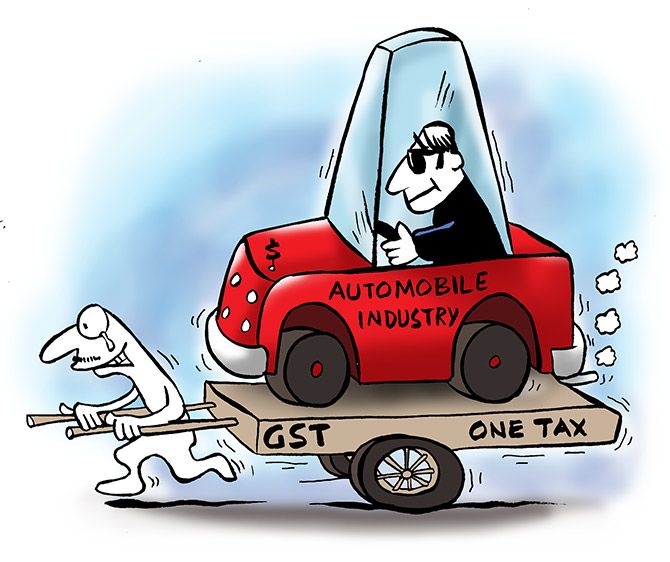Among other things GST will yield ‘better value for money’ for car buyers, increasing automobile industry demand, says Sandip Neogi.
Illustration: Uttam Ghosh/Rediff.com.

The crown of being modern India’s biggest tax reform seems to be sitting easy on the head of the goods and service tax (GST), looking at the first several weeks of its implementation.
Make no mistake, this will be one of the most challenging tax regime transitions undertaken anywhere in the world, with significant pain points.
However, the GST’s pace and decisiveness, and its bold design, should ensure that it brings greater national fiscal discipline.
As always, India has demonstrated how fast it can adapt to multiple changes when led by the right tone and intent. The Fiscal Responsibility and Budget Management (FRBM) Act (2003) was brought with the same intent — creating an institutional mechanism to keep the fiscal deficit under check.
While FRBM is still under debate, one should consider it as a preamble to bigger reform. With the GST’s implementation, the nation has a new mantra — ‘One Tax, One Economy, One Nation’.
The GST roll-out and consequent retail price reductions by original equipment manufacturers (OEMs) soon afterward is an excellent example of collaboration between the government and the automobile industry.
It has been a rare instance when industry stakeholders unanimously supported a seamless transition to a new paradigm, ensuring that customers get the best outcomes.
Post-GST price cuts will provide fillip to consumer demand in the coming months, and help usher in an era of progressive growth.
Like demonetisation, the GST reform is a disruptive, long-term move to improve the nation’s overall economic state. The most-effective impact of the GST will be in terms of improving the ease of doing business — especially by making ‘paying taxes’ easier.
Long-term benefits of the GST are well known; the challenge now is to swiftly address short-term complications. It is thus essential to plan and take measured steps in the initial transitional period to avoid any roadblocks, and realise the full potential of this reform in terms of productivity and efficiency.
As many as 140 countries, including Australia, Malaysia, Singapore, Austria, New Zealand, Russia, and China have already introduced the GST.
India can, therefore, learn the international best practices and implementation insights. However, it is the Canadian dual GST model that our tax reform is closest to.
New growth phase
Under the previous tax regime, the GST sector faced several taxes, such as excise, VAT (value added tax), sales tax, and motor vehicle tax on cars and bikes — all subsumed by the GST.
Although some uncertainty remains due to incentives/exemptions provided by different states towards manufacturing, the GST reform is a step towards creating critical auto sector demand.
The GST will reduce overall tax costs for manufacturers; with the supply chain in the GST net, manufacturers will be able to claim input credits for most procurements.
Electric over Hybrid
Hybrids have been included in the 28 per cent bracket, along with the highest cess of 15 per cent, which has discouraged both buyers and manufacturers.
Recently, the government also withdrew a subsidy for hybrid vehicles under the FAME (Faster Adoption and Manufacturing of Hybrid and Electric Vehicles in India) India scheme, implemented to promote hybrid and electric vehicle production in early April.
However, tax on electric vehicles has been kept at 12 per cent. Of late, the Indian government has been more supportive of electric vehicles, while seemingly alienating hybrids. This has led to mixed reactions from auto experts, manufacturers and those campaigning for sustainable mobility.
While some are welcoming the government’s move and have begun discussion on the lack of electric vehicle support infrastructure, a few still believe that hybrids are a viable substitute to address emission concerns, until India has an eco-friendly transport system in place.
Win for consumers
With 80 per cent of goods falling under the 12 per cent and the 18 per cent brackets leading to a fall in prices, the GST will enhance consumer buying power without real increase in incomes, spurring demand across sectors.
It will yield ‘better value for money’ for car buyers, increasing automobile industry demand.
So, it is time for consumers to stop looking at the GST with fear and instead start educating themselves. Policymakers have ensured that the GST rates are in tandem with existing incidence of taxation, potentially offsetting any price-rise concerns.
The government and the auto industry are combining their efforts to dispel any issues customers might face.
The way forward
To conclude, GST will ensure better transparency, lower inflation, improved ease of doing business and increased tax-compliance.
It has been introduced to ensure a more unified market and to reduce cascading of taxes, though state governments are considering increasing road taxes, which is currently outside the GST’s purview.
This move can dampen prospects offered under the ‘One Tax’ reform. These bottlenecks must be addressed for maximum consumer benefits to help stimulate auto sector demand, and boost medium and long-term economic activities.
Sandip Neogi is the chief financial officer of Nissan India.











